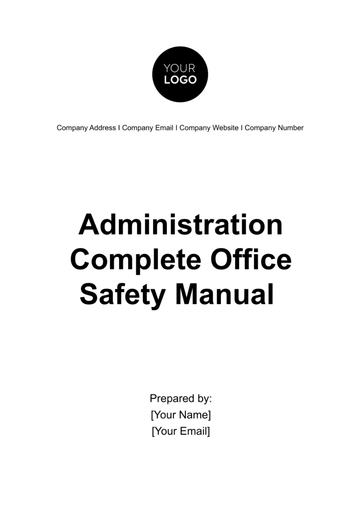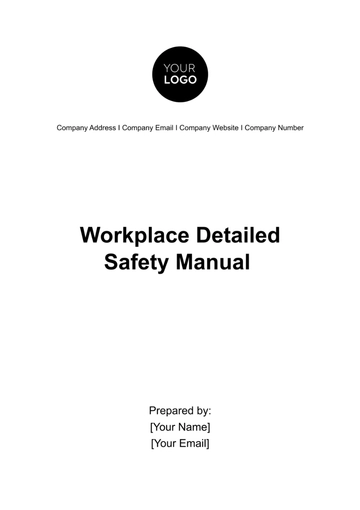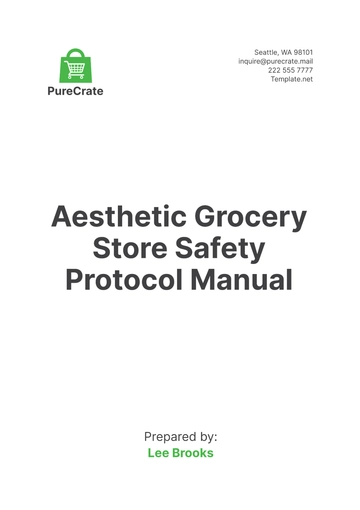Free Health & Safety Committee Training Manual

I. Introduction to Health & Safety
Purpose of the Training Manual: This manual serves as a vital resource for both new and existing committee members, offering a comprehensive overview of health and safety protocols, policies, and best practices. |
Overview of Health & Safety Principles: It contains fundamental health and safety concepts such as hazard identification, risk mitigation, and the importance of creating a safe working environment. It also covers the ethical and legal obligations of the organization regarding employee health and safety. |
Role of the Health & Safety Committee: The committee has pivotal role in monitoring, advising on, and enforcing health and safety standards. The section emphasizes the committee's responsibility to foster a culture of safety and its impact on employee well-being and organizational success. |
II. Committee Structure and Member Roles
Detailed information on the composition and function of the Health & Safety Committee.
A. Composition of the Committee
An outline of the various roles within the committee, including specific duties and responsibilities of each position, such as the Chairperson, Safety Officers, and other members.
Role in Committee | Duties and Responsibilities |
Chairperson | Leads the committee, sets agendas, coordinates meetings |
Vice-Chair | Assists the Chairperson, takes charge in their absence |
Safety Officers | Provides technical safety expertise, leads risk assessments |
HR Representatives | Advises on HR-related safety matters, manages training records |
Employee Representatives | Represents the workforce, voices employee safety concerns |
Secretary | Maintains records, handles committee correspondence |
B. Responsibilities of Committee Members
In-depth description of the tasks and responsibilities associated with each role, including conducting safety audits, policy formulation, and employee safety advocacy.
Role in Committee | Key Responsibilities |
Chairperson | Ensures effective functioning of the committee, liaises with management |
Vice-Chair | Supports the Chairperson, oversees sub-committee activities |
Safety Officers | Conducts safety audits, recommends safety improvements |
HR Representatives | Coordinates safety training, manages compliance documentation |
Employee Representatives | Engages with employees, collects feedback on safety issues |
Secretary | Documents meeting minutes, maintains safety records |
C. Communication and Collaboration
Guidelines on effective communication strategies within the committee and best practices for collaborating with other departments to implement safety policies and initiatives across the organization.
Aspect | Description |
Internal Communication | Regular updates within the committee, and across the organization |
Collaboration with Departments | Working with various departments for policy implementation and feedback |
Reporting and Liaising | Regular reporting to management and liaising with external safety bodies |
III. Health & Safety Policies and Procedures
An overview of the organization’s current safety policies and the process of maintaining and updating them.
A. Overview of Company Safety Policies
A detailed review of existing safety policies, covering areas such as emergency procedures, equipment handling, workplace ergonomics, and incident reporting.
Safety Policy Area | Key Components |
Emergency Procedures | Evacuation plans, first-aid, and emergency contacts |
Equipment Handling | Safe use of machinery and tools, maintenance protocols |
Workplace Ergonomics | Proper workstation setup, regular ergonomic assessments |
Incident Reporting | Procedures for reporting accidents and near-misses |
B. Procedure for Developing and Reviewing Policies
Step-by-step guide on how to develop new safety policies and regularly review and update existing ones, including the process for stakeholder consultation and approval.
Stage | Description |
Policy Development | Identify need, draft policy, consult stakeholders |
Policy Review | Regular review of policies for relevance and effectiveness |
Stakeholder Consultation | Engage with employees, management, and external experts for input |
Approval Process | Final approval by Health & Safety Committee and senior management |
C. Compliance and Legal Requirements
Detailed information on relevant health and safety laws and regulations, and the importance of ensuring company-wide compliance to avoid legal liabilities and maintain a safe working environment.
Compliance Area | Key Elements |
Regulatory Compliance | Adherence to OSHA standards, local safety laws |
Legal Documentation | Maintenance of safety records, compliance reports |
Training on Legal Requirements | Regular training for employees on legal safety obligations |
IV. Risk Assessment and Management
Guidance on how to conduct effective risk assessments and manage potential workplace hazards.
A. Conducting Risk Assessments
Comprehensive instructions for performing risk assessments, including identifying potential hazards, evaluating the likelihood and impact of these hazards, and documenting the findings.
Step in Risk Assessment | Description | Example |
Hazard Identification | Identifying potential hazards in the workplace | Example: Slippery floors, exposed electrical wiring |
Risk Evaluation | Assessing the likelihood and impact of hazards | Likelihood: High; Impact: Moderate |
Documentation | Recording the findings of the risk assessment | Documenting identified hazards and their assessments |
B. Mitigation Strategies
Detailed strategies for reducing identified risks, including the implementation of control measures like engineering controls, safe work procedures, and the use of personal protective equipment.
Identified Risk | Mitigation Strategy | Implementation Detail |
Slippery Floors | Engineering Control: Anti-slip flooring | Installation in high-traffic areas |
Exposed Electrical Wiring | Safe Work Procedures: Regular electrical safety checks | Monthly inspections by maintenance team |
Use of Hazardous Materials | PPE: Provision of appropriate protective equipment | Supply of gloves, goggles, and aprons |
C. Emergency Response Planning
Detailed procedures for developing, maintaining, and testing emergency response plans for various scenarios, emphasizing the importance of preparedness in minimizing harm during emergencies.
Emergency Scenario | Response Plan Component | Plan Detail |
Fire Emergency | Evacuation Plan | Designated escape routes and assembly points |
Medical Emergency | First-Aid Response | On-site first-aid kits and trained personnel |
Natural Disaster | Shelter-in-Place Procedures | Identification of safe zones in the workplace |
V. Training and Education
Focuses on the development and implementation of effective safety training programs.
A. Developing Training Programs
Guidelines for designing comprehensive safety training programs that are tailored to various job roles and risks within the organization, including the use of engaging and interactive training methods.
Aspect of Training Program | Description | Example |
Program Design | Tailoring content to specific roles and risks | Customized training for machine operators, office ergonomics for administrative staff |
Training Methods | Utilizing engaging and interactive techniques | Hands-on exercises, simulations, e-learning modules |
Training Frequency | Scheduling regular training sessions | Annual mandatory safety training, quarterly refreshers |
B. Monitoring and Evaluation of Training
Methods for evaluating the effectiveness of training programs, including assessing participant feedback, conducting post-training assessments, and monitoring safety performance indicators.
Evaluation Method | Purpose | Implementation |
Participant Feedback | Gauging participant satisfaction and learning | Post-training surveys or feedback forms |
Post-Training Assessment | Measuring knowledge and skills retention | Tests or practical assessments post-training |
Safety Performance Indicators | Tracking application of training in the workplace | Monitoring incident rates, near-misses, safety violations |
C. Ongoing Education and Awareness
Strategies for ensuring continuous safety awareness among employees through regular communications, safety campaigns, and provision of up-to-date safety information.
Awareness Strategy | Description | Example |
Regular Communications | Keeping safety top-of-mind among employees | Monthly safety newsletters, safety alerts |
Safety Campaigns | Themed campaigns to promote specific aspects of safety | Annual 'Safety Week' with activities and workshops |
Updated Safety Information | Providing current and relevant safety resources | Access to an online safety resource library, regular safety bulletins |
Prepared by:
[Your Name]
[Your Job Title]
[Your Company]
© [Year] [Your Company Name]. All Rights Reserved.
- 100% Customizable, free editor
- Access 1 Million+ Templates, photo’s & graphics
- Download or share as a template
- Click and replace photos, graphics, text, backgrounds
- Resize, crop, AI write & more
- Access advanced editor
Enhance workplace safety with Template.net's Health & Safety Committee Training Manual Template. This editable and customizable resource, powered by our Ai Editor Tool, equips you to craft comprehensive training manuals tailored to your organization's needs. Elevate your safety protocols effortlessly with Template.net's user-friendly solutions.





























